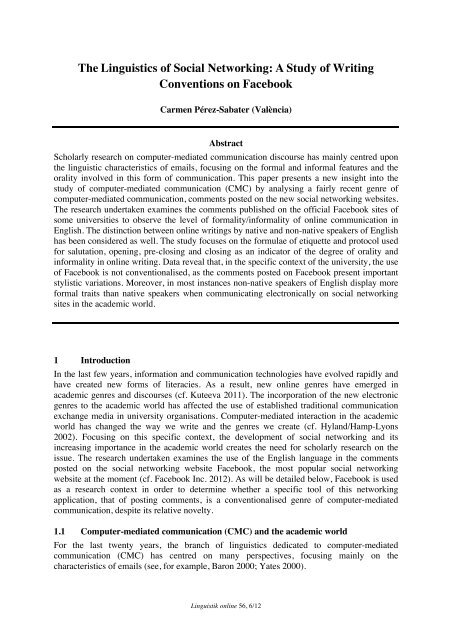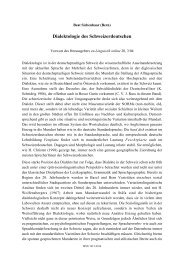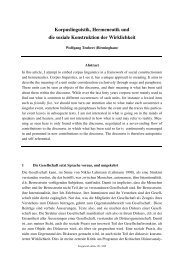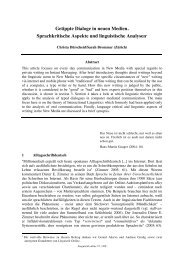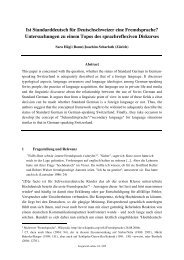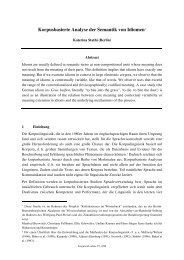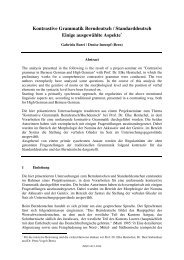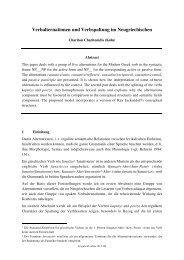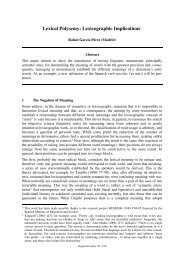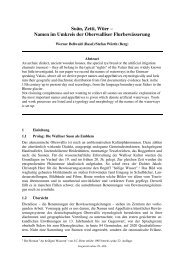A Study of Writing Conventions on Facebook - Linguistik online
A Study of Writing Conventions on Facebook - Linguistik online
A Study of Writing Conventions on Facebook - Linguistik online
Create successful ePaper yourself
Turn your PDF publications into a flip-book with our unique Google optimized e-Paper software.
The Linguistics <str<strong>on</strong>g>of</str<strong>on</strong>g> Social Networking: A <str<strong>on</strong>g>Study</str<strong>on</strong>g> <str<strong>on</strong>g>of</str<strong>on</strong>g> <str<strong>on</strong>g>Writing</str<strong>on</strong>g><str<strong>on</strong>g>C<strong>on</strong>venti<strong>on</strong>s</str<strong>on</strong>g> <strong>on</strong> <strong>Facebook</strong>Carmen Pérez-Sabater (València)AbstractScholarly research <strong>on</strong> computer-mediated communicati<strong>on</strong> discourse has mainly centred up<strong>on</strong>the linguistic characteristics <str<strong>on</strong>g>of</str<strong>on</strong>g> emails, focusing <strong>on</strong> the formal and informal features and theorality involved in this form <str<strong>on</strong>g>of</str<strong>on</strong>g> communicati<strong>on</strong>. This paper presents a new insight into thestudy <str<strong>on</strong>g>of</str<strong>on</strong>g> computer-mediated communicati<strong>on</strong> (CMC) by analysing a fairly recent genre <str<strong>on</strong>g>of</str<strong>on</strong>g>computer-mediated communicati<strong>on</strong>, comments posted <strong>on</strong> the new social networking websites.The research undertaken examines the comments published <strong>on</strong> the <str<strong>on</strong>g>of</str<strong>on</strong>g>ficial <strong>Facebook</strong> sites <str<strong>on</strong>g>of</str<strong>on</strong>g>some universities to observe the level <str<strong>on</strong>g>of</str<strong>on</strong>g> formality/informality <str<strong>on</strong>g>of</str<strong>on</strong>g> <strong>on</strong>line communicati<strong>on</strong> inEnglish. The distincti<strong>on</strong> between <strong>on</strong>line writings by native and n<strong>on</strong>-native speakers <str<strong>on</strong>g>of</str<strong>on</strong>g> Englishhas been c<strong>on</strong>sidered as well. The study focuses <strong>on</strong> the formulae <str<strong>on</strong>g>of</str<strong>on</strong>g> etiquette and protocol usedfor salutati<strong>on</strong>, opening, pre-closing and closing as an indicator <str<strong>on</strong>g>of</str<strong>on</strong>g> the degree <str<strong>on</strong>g>of</str<strong>on</strong>g> orality andinformality in <strong>on</strong>line writing. Data reveal that, in the specific c<strong>on</strong>text <str<strong>on</strong>g>of</str<strong>on</strong>g> the university, the use<str<strong>on</strong>g>of</str<strong>on</strong>g> <strong>Facebook</strong> is not c<strong>on</strong>venti<strong>on</strong>alised, as the comments posted <strong>on</strong> <strong>Facebook</strong> present importantstylistic variati<strong>on</strong>s. Moreover, in most instances n<strong>on</strong>-native speakers <str<strong>on</strong>g>of</str<strong>on</strong>g> English display moreformal traits than native speakers when communicating electr<strong>on</strong>ically <strong>on</strong> social networkingsites in the academic world.1 Introducti<strong>on</strong>In the last few years, informati<strong>on</strong> and communicati<strong>on</strong> technologies have evolved rapidly andhave created new forms <str<strong>on</strong>g>of</str<strong>on</strong>g> literacies. As a result, new <strong>on</strong>line genres have emerged inacademic genres and discourses (cf. Kuteeva 2011). The incorporati<strong>on</strong> <str<strong>on</strong>g>of</str<strong>on</strong>g> the new electr<strong>on</strong>icgenres to the academic world has affected the use <str<strong>on</strong>g>of</str<strong>on</strong>g> established traditi<strong>on</strong>al communicati<strong>on</strong>exchange media in university organisati<strong>on</strong>s. Computer-mediated interacti<strong>on</strong> in the academicworld has changed the way we write and the genres we create (cf. Hyland/Hamp-Ly<strong>on</strong>s2002). Focusing <strong>on</strong> this specific c<strong>on</strong>text, the development <str<strong>on</strong>g>of</str<strong>on</strong>g> social networking and itsincreasing importance in the academic world creates the need for scholarly research <strong>on</strong> theissue. The research undertaken examines the use <str<strong>on</strong>g>of</str<strong>on</strong>g> the English language in the commentsposted <strong>on</strong> the social networking website <strong>Facebook</strong>, the most popular social networkingwebsite at the moment (cf. <strong>Facebook</strong> Inc. 2012). As will be detailed below, <strong>Facebook</strong> is usedas a research c<strong>on</strong>text in order to determine whether a specific tool <str<strong>on</strong>g>of</str<strong>on</strong>g> this networkingapplicati<strong>on</strong>, that <str<strong>on</strong>g>of</str<strong>on</strong>g> posting comments, is a c<strong>on</strong>venti<strong>on</strong>alised genre <str<strong>on</strong>g>of</str<strong>on</strong>g> computer-mediatedcommunicati<strong>on</strong>, despite its relative novelty.1.1 Computer-mediated communicati<strong>on</strong> (CMC) and the academic worldFor the last twenty years, the branch <str<strong>on</strong>g>of</str<strong>on</strong>g> linguistics dedicated to computer-mediatedcommunicati<strong>on</strong> (CMC) has centred <strong>on</strong> many perspectives, focusing mainly <strong>on</strong> thecharacteristics <str<strong>on</strong>g>of</str<strong>on</strong>g> emails (see, for example, Bar<strong>on</strong> 2000; Yates 2000).<strong>Linguistik</strong> <strong>on</strong>line 56, 6/12
82<strong>Linguistik</strong> <strong>on</strong>line 56, 6/12Regarding the language used in emails, although written, its style has been characterised aswritten speech (Maynor 1994), or "as an emerging language centaur–part speech, partwriting" (Bar<strong>on</strong> 2000: 248). The oral and highly informal traits <str<strong>on</strong>g>of</str<strong>on</strong>g> email have been pointedout by Yates/Orlikowski (1992) in c<strong>on</strong>trast with the language used in traditi<strong>on</strong>al memos (seeCho 2010 for a recent reformulati<strong>on</strong> <str<strong>on</strong>g>of</str<strong>on</strong>g> this perspective). In relati<strong>on</strong> to these oral traits, thedialogic nature <str<strong>on</strong>g>of</str<strong>on</strong>g> emails has been underlined. This characteristic <str<strong>on</strong>g>of</str<strong>on</strong>g> email messages could beextended to other CMC genres (cf. Pérez-Sabater 2011). The dialogic nature <str<strong>on</strong>g>of</str<strong>on</strong>g> <strong>on</strong>line genreshas a close relati<strong>on</strong>ship with the c<strong>on</strong>cept used by Bakhtin (1986) in his literary theory, wherethe dialogic character <str<strong>on</strong>g>of</str<strong>on</strong>g> literature is emphasised as being in communicati<strong>on</strong> with otherprevious or future works, and the dialogic character <str<strong>on</strong>g>of</str<strong>on</strong>g> language is also postulated as being inresp<strong>on</strong>se to what has been said or is going to be said. Language is relati<strong>on</strong>al and engaged in aprocess, as are these <strong>on</strong>line writings; they are, in most cases, in resp<strong>on</strong>se to other previouscommunicati<strong>on</strong>s, and are linked to future <strong>on</strong>es.In the field <str<strong>on</strong>g>of</str<strong>on</strong>g> English for Academic or Special Purposes, some stylistic protocols have beendeveloped so as to use this means <str<strong>on</strong>g>of</str<strong>on</strong>g> communicati<strong>on</strong> pr<str<strong>on</strong>g>of</str<strong>on</strong>g>iciently with an adequate level <str<strong>on</strong>g>of</str<strong>on</strong>g>formality in business, academic or pers<strong>on</strong>al emails, (see for example Emmers<strong>on</strong> 2004).Emails were originally designed for academic-organisati<strong>on</strong>al purposes (cf. Yates 2000). Inacademic settings, email messages are the most popular genre <str<strong>on</strong>g>of</str<strong>on</strong>g> computer-mediatedcommunicati<strong>on</strong> used by administrators and academics. In the survey carried out byZimmerman/Bar-Ilan (2009), 96.9% <str<strong>on</strong>g>of</str<strong>on</strong>g> academics use it regularly. On the c<strong>on</strong>trary, emaildoesn't seem to suit the communicative needs <str<strong>on</strong>g>of</str<strong>on</strong>g> university students who c<strong>on</strong>sider it to<str<strong>on</strong>g>of</str<strong>on</strong>g>ormal, and <strong>on</strong>ly adequate for communicating with teachers (cf. Yus 2011).As for the linguistics <str<strong>on</strong>g>of</str<strong>on</strong>g> this <strong>on</strong>line genre, participants' use <str<strong>on</strong>g>of</str<strong>on</strong>g> the language is usually moreformal than in synchr<strong>on</strong>ous discussi<strong>on</strong>, since authors have more time to plan their writing and,thus, pay more attenti<strong>on</strong> to form. Nevertheless, depending <strong>on</strong> the topic discussed, the formalcharacter <str<strong>on</strong>g>of</str<strong>on</strong>g> <strong>on</strong>line fora can vary; this linguistic variati<strong>on</strong> is perceived in the discussi<strong>on</strong> <str<strong>on</strong>g>of</str<strong>on</strong>g> foradedicated to entertainment topics, such as pr<str<strong>on</strong>g>of</str<strong>on</strong>g>anity (cf. Herring 2001), or in football fora,compared to fora devoted to serious political topics (cf. M<strong>on</strong>tero-Fleta et al. 2009). In theuniversity, <strong>on</strong>line fora are available in many situati<strong>on</strong>s where student interacti<strong>on</strong> is enhanced,for example, in some subjects or some organisati<strong>on</strong>s within the university, like students'uni<strong>on</strong>s.1.2 The social networking site <strong>Facebook</strong>The growth <str<strong>on</strong>g>of</str<strong>on</strong>g> Web 2.0 has allowed many services to be created that facilitate collaborati<strong>on</strong> inthe World Wide Web. They are defined as "web-based services that allow individuals toc<strong>on</strong>struct a public or semi-public pr<str<strong>on</strong>g>of</str<strong>on</strong>g>ile … articulate a list <str<strong>on</strong>g>of</str<strong>on</strong>g> other users with whom theyshare a c<strong>on</strong>necti<strong>on</strong> and view and traverse their list <str<strong>on</strong>g>of</str<strong>on</strong>g> c<strong>on</strong>necti<strong>on</strong>s" (Boyd/Ellis<strong>on</strong> 2008: 211).The affordances and reach <str<strong>on</strong>g>of</str<strong>on</strong>g> this emergent phenomen<strong>on</strong> are increasingly attracting theattenti<strong>on</strong> <str<strong>on</strong>g>of</str<strong>on</strong>g> scholars to the study <str<strong>on</strong>g>of</str<strong>on</strong>g> social networking (cf. Boyd/Ellis<strong>on</strong> 2008).In the last few years, some social networking sites have disappeared and some others aregaining users day by day. One <str<strong>on</strong>g>of</str<strong>on</strong>g> the top social networking websites at the moment is<strong>Facebook</strong>. Created in 2004 "as a cross between a tool for meeting new people and a platformfor networking with people you already know" (Bar<strong>on</strong> 2008: 84), <strong>Facebook</strong> has its origins inthe University <str<strong>on</strong>g>of</str<strong>on</strong>g> Harvard (cf. Boyd/Ellis<strong>on</strong> 2008). This website, privately owned by<strong>Facebook</strong>, Inc., was quickly transformed from a private club within the University <str<strong>on</strong>g>of</str<strong>on</strong>g> Harvardto a service open to every<strong>on</strong>e in 2006. On this social site, users create an <strong>on</strong>line pr<str<strong>on</strong>g>of</str<strong>on</strong>g>ile bylisting pers<strong>on</strong>al informati<strong>on</strong> and interests, link up with other users and share updates <str<strong>on</strong>g>of</str<strong>on</strong>g> theinformati<strong>on</strong> posted <strong>on</strong> a daily basis (cf. Hargittai/Hsieh 2011). Participants may use thisnetwork applicati<strong>on</strong> to interact with people they already know or to meet new people that areISSN 1615-3014
Carmen Pérez-Sabater:The linguistics <str<strong>on</strong>g>of</str<strong>on</strong>g> social networking: A study <str<strong>on</strong>g>of</str<strong>on</strong>g> writing c<strong>on</strong>venti<strong>on</strong>s <strong>on</strong> <strong>Facebook</strong>83called friends, that is, participants "who can post comments <strong>on</strong> each other's pages, and vieweach other's pr<str<strong>on</strong>g>of</str<strong>on</strong>g>iles" (Ellis<strong>on</strong> et al. 2007).The website includes several features, such as communicati<strong>on</strong> through private or publicmessages, a chat, <strong>on</strong>line fora, photos, videos, links, a pers<strong>on</strong>al Wall, and News Feed, wherefriends or participants can post their messages and comment <strong>on</strong> topics. The company isc<strong>on</strong>stantly modifying and improving the services provided, <str<strong>on</strong>g>of</str<strong>on</strong>g>fering more and more <strong>on</strong>lineservices.The most interesting characteristic <str<strong>on</strong>g>of</str<strong>on</strong>g> this site is that it enables a great variety <str<strong>on</strong>g>of</str<strong>on</strong>g> <strong>on</strong>line genresto be accessed through the same platform; these genres being both synchr<strong>on</strong>ous andasynchr<strong>on</strong>ous. They are easily identified and can be organised and customised in the way theuser <str<strong>on</strong>g>of</str<strong>on</strong>g> the site desires, some services can be visible to the whole <strong>on</strong>line community and somecannot. Battner/Fiori (2009) put forward that it is a tool that goes bey<strong>on</strong>d synchr<strong>on</strong>ous andasynchr<strong>on</strong>ous technologies; as part <str<strong>on</strong>g>of</str<strong>on</strong>g> Web 2.0 principles, it is a participatory platform whereusers can add informati<strong>on</strong> or modify the informati<strong>on</strong> already <strong>on</strong>line, for example, a user cantag the pictures uploaded by adding the names <str<strong>on</strong>g>of</str<strong>on</strong>g> the people or a descripti<strong>on</strong>. Any user cancreate a group and this can be open to other users, or restricted to a pre-selected community(cf. Battner/Fiori 2009). It is also interesting to point out that the original platform designed tokeep in touch effectively with former classmates has evolved into a more diversified <strong>on</strong>linetool. Now, <strong>Facebook</strong> is used as a platform for <strong>on</strong>line communities that share interests in manyfields: these being political, sportive, educati<strong>on</strong>al, scientific, commercial, or entertainment,am<strong>on</strong>g others. The typical user spends more than 20 minutes daily and logs <strong>on</strong> at least <strong>on</strong>ce aday (cf. Ellis<strong>on</strong> et al. 2007).As for the research carried out <strong>on</strong> <strong>Facebook</strong>, most scholars have analysed the use <str<strong>on</strong>g>of</str<strong>on</strong>g> <strong>Facebook</strong>from a sociological or pragmatic approach identifying the sense <str<strong>on</strong>g>of</str<strong>on</strong>g> community in therelati<strong>on</strong>ship between participants in social networking (cf. Ellis<strong>on</strong> et al. 2007; Bar<strong>on</strong> 2008;Papacharissi 2011; Yus 2011). It has also been studied as a platform to enhance learning (seefor example, Blattner/Fiori 2009). In c<strong>on</strong>trast, little is known about the linguistics <str<strong>on</strong>g>of</str<strong>on</strong>g> this<strong>on</strong>line social networking website. Literature <strong>on</strong> the study <str<strong>on</strong>g>of</str<strong>on</strong>g> the linguistic aspects <str<strong>on</strong>g>of</str<strong>on</strong>g> the socialnetworking website <strong>Facebook</strong> is very scarce; the reas<strong>on</strong> for this may not <strong>on</strong>ly be because <str<strong>on</strong>g>of</str<strong>on</strong>g>its novelty but also because <str<strong>on</strong>g>of</str<strong>on</strong>g> the fact that it is very complex to study, as several genres arec<strong>on</strong>current <strong>on</strong> <strong>on</strong>e social networking website. In research about the use <str<strong>on</strong>g>of</str<strong>on</strong>g> this site as ateaching tool, Blattner/Fiori (2009: 24) point out that participants <strong>on</strong> the social networkingwebsite <strong>Facebook</strong> use more colloquial language in their speech acts and the tool "exposeslearners to language varieties […] that language departments and textbooks cannot match".The use <str<strong>on</strong>g>of</str<strong>on</strong>g> <strong>Facebook</strong> in the university is more and more important: while emails are the mostpopular <strong>on</strong>line genre for academics and administrati<strong>on</strong>, students now prefer to use socialnetworking websites to communicate with other students; they are Internet "natives" whomake competent daily use <str<strong>on</strong>g>of</str<strong>on</strong>g> these services (cf. Kuteeva 2011). Between 80% to 90% <str<strong>on</strong>g>of</str<strong>on</strong>g> thestudents <strong>on</strong> American campuses had <strong>Facebook</strong> accounts in 2006 (cf. Bar<strong>on</strong> 2008).Hargittai/Hsieh (2011) point out that <strong>Facebook</strong> was the most popular social networking site intheir survey carried out at the University <str<strong>on</strong>g>of</str<strong>on</strong>g> Illinois, Chicago, during 2006–2007, where 79%<str<strong>on</strong>g>of</str<strong>on</strong>g> the students interviewed used it. Recently, <strong>Facebook</strong> has underg<strong>on</strong>e a spectacular increasein users. <strong>Facebook</strong> itself estimates that more than 800 milli<strong>on</strong> people are active users inJanuary 2012 and its use is increasing all over the world (<strong>Facebook</strong> Inc. 2012). The currentrelevance <str<strong>on</strong>g>of</str<strong>on</strong>g> <strong>Facebook</strong> has raised some voices <str<strong>on</strong>g>of</str<strong>on</strong>g> a possible competiti<strong>on</strong> between networkingtools and, for example, email, however, as Cho (2010: 1) indicates, "evidence is inc<strong>on</strong>clusiveas to whether social networking services compete or facilitate email usage".In this c<strong>on</strong>text, in order to fulfil the objectives <str<strong>on</strong>g>of</str<strong>on</strong>g> this research, a corpus <str<strong>on</strong>g>of</str<strong>on</strong>g> comments sent to<strong>Facebook</strong> websites <str<strong>on</strong>g>of</str<strong>on</strong>g> universities has been gathered over the last 2 years. As will be detailedISSN 1615-3014
84<strong>Linguistik</strong> <strong>on</strong>line 56, 6/12below, the study analyses the opening and closing formulae used in this genre, available bythis fairly recent applicati<strong>on</strong>, in order to observe the degree <str<strong>on</strong>g>of</str<strong>on</strong>g> formality and informality theEnglish language presents in a specific <strong>on</strong>line envir<strong>on</strong>ment. The distincti<strong>on</strong> between nativeand n<strong>on</strong>-native speakers <str<strong>on</strong>g>of</str<strong>on</strong>g> English is also a parameter <str<strong>on</strong>g>of</str<strong>on</strong>g> academic interest.The research presented in this article forms part <str<strong>on</strong>g>of</str<strong>on</strong>g> what could be called the forth step in theresearch <str<strong>on</strong>g>of</str<strong>on</strong>g> computer-mediated communicati<strong>on</strong> (CMC), which deals with the study <str<strong>on</strong>g>of</str<strong>on</strong>g>electr<strong>on</strong>ic discourse in languages other than English, in n<strong>on</strong>-angloph<strong>on</strong>e fora or in n<strong>on</strong>-English-dominant countries, studies <str<strong>on</strong>g>of</str<strong>on</strong>g> special relevance according to Murray (2000). Thestudy <str<strong>on</strong>g>of</str<strong>on</strong>g> the linguistics <str<strong>on</strong>g>of</str<strong>on</strong>g> <strong>Facebook</strong> is especially interesting due to its novelty, widespread useand the importance it is gaining in everyday life.In the specific field <str<strong>on</strong>g>of</str<strong>on</strong>g> English for Academic Purposes, little attenti<strong>on</strong> has been devoted to theimpact <str<strong>on</strong>g>of</str<strong>on</strong>g> the new genres developed by the Internet. The need to examine the changes that thenew <strong>on</strong>line genres imply for academic literacy practices is posed by Hyland/Hamp-Ly<strong>on</strong>s(2002). More recently, Kuteeva (2011) has enhanced the study <str<strong>on</strong>g>of</str<strong>on</strong>g> the new <strong>on</strong>line tools <str<strong>on</strong>g>of</str<strong>on</strong>g>feredby Web 2.0 in more specific c<strong>on</strong>texts, in light <str<strong>on</strong>g>of</str<strong>on</strong>g> the paucity <str<strong>on</strong>g>of</str<strong>on</strong>g> scholarly research realised upto date.2 Materials and Methods2.1 CorpusThe corpus <str<strong>on</strong>g>of</str<strong>on</strong>g> the study has been collected by the author during 2009 and 2010. It comprises300 comments posted to the <str<strong>on</strong>g>of</str<strong>on</strong>g>ficial <strong>Facebook</strong> sites <str<strong>on</strong>g>of</str<strong>on</strong>g> universities in Europe and The UnitedStates <str<strong>on</strong>g>of</str<strong>on</strong>g> America such as the University <str<strong>on</strong>g>of</str<strong>on</strong>g> Southern Denmark, The University <str<strong>on</strong>g>of</str<strong>on</strong>g> Edinburgh,The University <str<strong>on</strong>g>of</str<strong>on</strong>g> Manchester, The University <str<strong>on</strong>g>of</str<strong>on</strong>g> Oxford, The University <str<strong>on</strong>g>of</str<strong>on</strong>g> Warwick, FloridaState University, Ohio State University, The University <str<strong>on</strong>g>of</str<strong>on</strong>g> Harvard, The University <str<strong>on</strong>g>of</str<strong>on</strong>g> Texas,and The University <str<strong>on</strong>g>of</str<strong>on</strong>g> Washingt<strong>on</strong>. All the texts studied have been written and posted <strong>on</strong> the<str<strong>on</strong>g>of</str<strong>on</strong>g>ficial sites <str<strong>on</strong>g>of</str<strong>on</strong>g> the universities menti<strong>on</strong>ed. The reas<strong>on</strong> why these sites have been chosen is,firstly, because they are freely accessed sites open to the whole <strong>on</strong>line community, that is, nomember registrati<strong>on</strong> is needed to access the site; sec<strong>on</strong>dly, the language <str<strong>on</strong>g>of</str<strong>on</strong>g> communicati<strong>on</strong> <strong>on</strong>these sites is mostly English.Some c<strong>on</strong>siderati<strong>on</strong>s about free access and privacy matters should be nuanced. Although theaccess <str<strong>on</strong>g>of</str<strong>on</strong>g> these sites is free, no authentic private informati<strong>on</strong> is published in the examplesprovided in this study. Private pers<strong>on</strong>al informati<strong>on</strong> <strong>on</strong> the comments has been modified,keeping similarities with the original as a pro<str<strong>on</strong>g>of</str<strong>on</strong>g> <str<strong>on</strong>g>of</str<strong>on</strong>g> the authenticity <str<strong>on</strong>g>of</str<strong>on</strong>g> the written word, inaccordance with the publicati<strong>on</strong> <str<strong>on</strong>g>of</str<strong>on</strong>g> early collecti<strong>on</strong>s <str<strong>on</strong>g>of</str<strong>on</strong>g> letters (cf. Gurkin 1986). Authenticityhas been a c<strong>on</strong>troversial issue since Medieval England as a criteri<strong>on</strong> <str<strong>on</strong>g>of</str<strong>on</strong>g> source <str<strong>on</strong>g>of</str<strong>on</strong>g> authority inwriting since the authority <str<strong>on</strong>g>of</str<strong>on</strong>g> a text depended not <strong>on</strong>ly <strong>on</strong> intrinsic worth but also <strong>on</strong>authenticity; the criteri<strong>on</strong> demanded that the author be identifiable (cf. Bar<strong>on</strong> 2000). In thelast decade, the issue has gained importance in some areas such as sociolinguistics andanthropological studies (see, for example, Coupland 2003). As for computer-mediatedcommunicati<strong>on</strong>, in this research it is necessary to focus <strong>on</strong> Bar<strong>on</strong>'s (2000) proposals when shepoints out that in <strong>on</strong>line writing the traditi<strong>on</strong>al boundary between author and audience mergesand "the noti<strong>on</strong>s <str<strong>on</strong>g>of</str<strong>on</strong>g> authority, resp<strong>on</strong>sibility, and ownership tend to crumble" (Bar<strong>on</strong> 2000:93). On <strong>Facebook</strong>, the platform allows users to decide what informati<strong>on</strong> about themselvesthey want to share with others; it is not to change identities but to present the best part <str<strong>on</strong>g>of</str<strong>on</strong>g> theuser to the others (cf. Bar<strong>on</strong> 2008). In this research, the presentati<strong>on</strong> <str<strong>on</strong>g>of</str<strong>on</strong>g> self is not questi<strong>on</strong>edor analysed, this could be a research topic in another study 1 . Thus, the informati<strong>on</strong> publishedby participants <strong>on</strong> their pr<str<strong>on</strong>g>of</str<strong>on</strong>g>iles c<strong>on</strong>cerning place <str<strong>on</strong>g>of</str<strong>on</strong>g> birth, place <str<strong>on</strong>g>of</str<strong>on</strong>g> living, and languages1 See Marwick (2005) for a study <strong>on</strong> authenticity and social networking.ISSN 1615-3014
Carmen Pérez-Sabater:The linguistics <str<strong>on</strong>g>of</str<strong>on</strong>g> social networking: A study <str<strong>on</strong>g>of</str<strong>on</strong>g> writing c<strong>on</strong>venti<strong>on</strong>s <strong>on</strong> <strong>Facebook</strong>85known, has been regarded as an authentic source <str<strong>on</strong>g>of</str<strong>on</strong>g> informati<strong>on</strong> to distinguish between nativespeakers <str<strong>on</strong>g>of</str<strong>on</strong>g> English and n<strong>on</strong>-native. In CMC the distincti<strong>on</strong> between native and n<strong>on</strong>-nativec<strong>on</strong>texts is a parameter <str<strong>on</strong>g>of</str<strong>on</strong>g> importance for authors like Lan (2000), Li (2000) and Ancarno(2005), am<strong>on</strong>g others. The difference between native and n<strong>on</strong>-native speakers <str<strong>on</strong>g>of</str<strong>on</strong>g> Englishalways refers to the author <str<strong>on</strong>g>of</str<strong>on</strong>g> the written comment. The number <str<strong>on</strong>g>of</str<strong>on</strong>g> native and n<strong>on</strong>-nativecomments analysed is equal, 150 in each category, following the suggesti<strong>on</strong>s <str<strong>on</strong>g>of</str<strong>on</strong>g> Rowe (2008).Lastly, as for the number <str<strong>on</strong>g>of</str<strong>on</strong>g> comments chosen, 300 posts was the work load the author couldhandle manually, since no s<str<strong>on</strong>g>of</str<strong>on</strong>g>tware aided analysis <str<strong>on</strong>g>of</str<strong>on</strong>g> language could be used for this research.2.2 Methodological c<strong>on</strong>siderati<strong>on</strong>s2.2.1 Methodological frameworkThe drift towards orality in the English language use posited by eminent scholars such asLeech (1966), Biber and Finegan (1989), and Fairclough (1992) has also been <str<strong>on</strong>g>of</str<strong>on</strong>g> interest incomputer-mediated communicati<strong>on</strong> (e. g. Bar<strong>on</strong> 2000). Some parameters have been used tomeasure the degree <str<strong>on</strong>g>of</str<strong>on</strong>g> orality and informality in the new electr<strong>on</strong>ic genres, like the number <str<strong>on</strong>g>of</str<strong>on</strong>g>words per sentence, the use <str<strong>on</strong>g>of</str<strong>on</strong>g> paralinguistic cues, informal language, spelling mistakes andcourtesy formulae (e. g. Pérez-Sabater et al. 2008b).Following the studies <strong>on</strong> email by Gains (1999), Bar<strong>on</strong> (2000), Waldvogel (2007), and Bou-Franch (2011), this research will examine the presence <str<strong>on</strong>g>of</str<strong>on</strong>g> the formulae <str<strong>on</strong>g>of</str<strong>on</strong>g> etiquette andprotocol used for salutati<strong>on</strong>, opening, pre-closing and closing in comments published <strong>on</strong> thesocial networking site <strong>Facebook</strong>. The findings will be compared with the results obtained inthis parameter in other studies <str<strong>on</strong>g>of</str<strong>on</strong>g> computer mediated communicati<strong>on</strong> discourse alreadypublished <strong>on</strong> other CMC genres widely used in the university such as email and <strong>on</strong>lineforums.Openings and closings, "the most salient structural features <str<strong>on</strong>g>of</str<strong>on</strong>g> an email" (Pérez-Sabater et al.:2008a), are norms developed to structure and regulate c<strong>on</strong>versati<strong>on</strong>s (cf. Murray 2000). Bar<strong>on</strong>(2000) points out that although salutati<strong>on</strong>s and farewells tend to be sparse in emails as thename <str<strong>on</strong>g>of</str<strong>on</strong>g> the sender and addressee are known, c<strong>on</strong>venti<strong>on</strong>s have evolved to open and closemessages. Danet (2002) underlines the redundancy <str<strong>on</strong>g>of</str<strong>on</strong>g> including these salutati<strong>on</strong>s and closingsas they appear at the top <str<strong>on</strong>g>of</str<strong>on</strong>g> the email. Other scholars also c<strong>on</strong>sider these elements as opti<strong>on</strong>alin emails, and therefore valuable for empirical research (cf. Bou-Franch 2011). On <strong>Facebook</strong>,in some cases the inclusi<strong>on</strong> <str<strong>on</strong>g>of</str<strong>on</strong>g> greetings and farewells may also be redundant and, therefore,<str<strong>on</strong>g>of</str<strong>on</strong>g> research value, in some other situati<strong>on</strong>s, these strategies may be necessary to work out thecurrent message's propositi<strong>on</strong>al meaning.2.2.2 Method <str<strong>on</strong>g>of</str<strong>on</strong>g> studyTo assess the formality or informality <str<strong>on</strong>g>of</str<strong>on</strong>g> the messages, the proposals <str<strong>on</strong>g>of</str<strong>on</strong>g> Pearce (2005),Duthler (2006) and the author's previous research (Pérez-Sabater et al. 2008a) are followed.Phatic communicati<strong>on</strong> in the form <str<strong>on</strong>g>of</str<strong>on</strong>g> greetings and farewell formulae have been studiedaccording to the criteria established after an initial examinati<strong>on</strong> <str<strong>on</strong>g>of</str<strong>on</strong>g> the corpus, where the usualrange <str<strong>on</strong>g>of</str<strong>on</strong>g> formulae from traditi<strong>on</strong>al letter writing is employed in some cases, while, in others,there is no use <str<strong>on</strong>g>of</str<strong>on</strong>g> these courtesy formulae. In this quantitative study, the corpus has beenanalysed following a scale ranging from "very formal" greetings and farewells to "veryinformal", using the criteria shown in Table 1. In this study, we associate the use <str<strong>on</strong>g>of</str<strong>on</strong>g>c<strong>on</strong>versati<strong>on</strong>al traits in written texts to informality, while formality is related to n<strong>on</strong>c<strong>on</strong>versati<strong>on</strong>aland impers<strong>on</strong>al registers (cf. Biber et al. 2002).Thus, greetings beginning with Dear Mr/Dr + sec<strong>on</strong>d name are c<strong>on</strong>sidered very formal, Dear+ first name formal, Hello + name informal and Hi, Hey or a name very informal. Similarly,ISSN 1615-3014
86<strong>Linguistik</strong> <strong>on</strong>line 56, 6/12sign-<str<strong>on</strong>g>of</str<strong>on</strong>g>fs like Yours sincerely are rated as very formal, Regards or Best wishes informal andCheers, Bye or Kisses very informal.ScalePunctuati<strong>on</strong>Very formal, separate from message body 1.0Very formal n<strong>on</strong>-separate 0.9Formal separate 0.8Formal n<strong>on</strong>-separate 0.7Informal separate 0.4Informal n<strong>on</strong>-separate 0.3Very informal separate 0.2Very informal n<strong>on</strong>-separate 0.1No greeting or farewell 0Table 1: Assignati<strong>on</strong> <str<strong>on</strong>g>of</str<strong>on</strong>g> formality degreeSec<strong>on</strong>dly, the number <str<strong>on</strong>g>of</str<strong>on</strong>g> steps involved in the farewell is counted, that is, if there is a <strong>on</strong>e-stepclosing or a two-step closing with a pre-closing <str<strong>on</strong>g>of</str<strong>on</strong>g> the type I look forward to hearing fromyou. No pre-closing scores 0, <strong>on</strong>e step closing scores 1 and 2 is assigned to two steps.Finally, it is worth menti<strong>on</strong>ing that two judges have been in charge <str<strong>on</strong>g>of</str<strong>on</strong>g> the coding process, asindicated by Duthler (2006). The results have been summed and averaged.2.3 Purpose <str<strong>on</strong>g>of</str<strong>on</strong>g> the studyThe comments posted <strong>on</strong> <strong>Facebook</strong> are characterised as asynchr<strong>on</strong>ous, that is, the mode <str<strong>on</strong>g>of</str<strong>on</strong>g>communicati<strong>on</strong> where the author and the reader are <strong>on</strong>line at different times (Yus 2011). Inc<strong>on</strong>trast to synchr<strong>on</strong>ous communicati<strong>on</strong>, asynchr<strong>on</strong>icity allows selective messagec<strong>on</strong>structi<strong>on</strong> (cf. Duthler 2006), authors are able to plan, review and c<strong>on</strong>trol their texts morethan in synchr<strong>on</strong>ous media like chats. C<strong>on</strong>sequently, asynchr<strong>on</strong>ous <strong>on</strong>line communicati<strong>on</strong>would allow a more formal style. Following this premise, the challenge <str<strong>on</strong>g>of</str<strong>on</strong>g> the study will betw<str<strong>on</strong>g>of</str<strong>on</strong>g>old:• To examine <strong>on</strong>line writings in <strong>on</strong>e specific setting, i. e. the university, to see how arecent electr<strong>on</strong>ic genre, without imposing guidelines <strong>on</strong> participants, behaves in theuse <str<strong>on</strong>g>of</str<strong>on</strong>g> openings and closings. The study <str<strong>on</strong>g>of</str<strong>on</strong>g> greetings and salutati<strong>on</strong>s is the parameterchosen to determine whether this tool <str<strong>on</strong>g>of</str<strong>on</strong>g> networking applicati<strong>on</strong>s is already ac<strong>on</strong>venti<strong>on</strong>alized CMC genre despite its newness.• To observe whether the writer's first language impinges up<strong>on</strong> the register and style <str<strong>on</strong>g>of</str<strong>on</strong>g>the comment, in other words, whether a different degree <str<strong>on</strong>g>of</str<strong>on</strong>g> formality/informality isfollowed by native and n<strong>on</strong>-native speakers in this specific genre <str<strong>on</strong>g>of</str<strong>on</strong>g> electr<strong>on</strong>iccommunicati<strong>on</strong>.The results are shown in the light <str<strong>on</strong>g>of</str<strong>on</strong>g> outstanding previous research.3 Results/Discussi<strong>on</strong>3.1 ResultsDue to the informality <str<strong>on</strong>g>of</str<strong>on</strong>g> the electr<strong>on</strong>ic medium, many academics have pointed out theopti<strong>on</strong>ality <str<strong>on</strong>g>of</str<strong>on</strong>g> opening and closing formulae in <strong>on</strong>line communicati<strong>on</strong> and their frequentabsence, especially in emails (cf. Bar<strong>on</strong> 1998; Yus 2001).Table 2 shows the results obtained as for the level <str<strong>on</strong>g>of</str<strong>on</strong>g> formality in openings and closings.ISSN 1615-3014
Carmen Pérez-Sabater:The linguistics <str<strong>on</strong>g>of</str<strong>on</strong>g> social networking: A study <str<strong>on</strong>g>of</str<strong>on</strong>g> writing c<strong>on</strong>venti<strong>on</strong>s <strong>on</strong> <strong>Facebook</strong>87Groups Openings Closings Secti<strong>on</strong>sComments <strong>on</strong> <strong>Facebook</strong> native 0,03 0,03 0,02Comments <strong>on</strong> <strong>Facebook</strong> n<strong>on</strong>-native 0,12 0,11 0,10Table 2: Results: level <str<strong>on</strong>g>of</str<strong>on</strong>g> formality in openings and closings3.1.1 OpeningsThe results <str<strong>on</strong>g>of</str<strong>on</strong>g> this research show that in the comments <str<strong>on</strong>g>of</str<strong>on</strong>g> native speakers <strong>on</strong> <strong>Facebook</strong>,participants use either a very informal greeting element or no greeting formulae, the absence<str<strong>on</strong>g>of</str<strong>on</strong>g> greetings is a frequent strategy in 20% <str<strong>on</strong>g>of</str<strong>on</strong>g> the cases studied. Similarly, in the research <str<strong>on</strong>g>of</str<strong>on</strong>g>business and academic emails carried out by Gains (1999), most <str<strong>on</strong>g>of</str<strong>on</strong>g> the business emails didn'tuse a greeting formula, while the academic used informal greetings; Li's (2000) data presentvery informal greetings and Chiluwa's (2010) business emails show very informalintroducti<strong>on</strong>s, as well. Thus, the informal results obtained in this research are the <strong>on</strong>es thatwould be expected in a priori informal CMC genre, as some previous studies <strong>on</strong> informalCMC genres such as <strong>on</strong>line fora or chats c<strong>on</strong>clude (e. g. M<strong>on</strong>tero-Fleta et al. 2009; Yus2001). On the other hand, the data shed light <strong>on</strong> some interesting issues that may need to becommented <strong>on</strong>.Firstly, in the comments <str<strong>on</strong>g>of</str<strong>on</strong>g> native speakers it is important the extensive use <str<strong>on</strong>g>of</str<strong>on</strong>g> addressivity:20% <str<strong>on</strong>g>of</str<strong>on</strong>g> the comments <strong>on</strong> <strong>Facebook</strong> analysed start their messages with the name or nickname<str<strong>on</strong>g>of</str<strong>on</strong>g> the intended addressee as in Example 1.Example 1. Native speakers.Darryl...buildings such as Thomps<strong>on</strong> Library are possible because <str<strong>on</strong>g>of</str<strong>on</strong>g> generous d<strong>on</strong>ors...nottuiti<strong>on</strong> fees. Go Bucks!The writer <str<strong>on</strong>g>of</str<strong>on</strong>g> this post needs to address a specific participant in the chained discussi<strong>on</strong> arisenabout the picture <str<strong>on</strong>g>of</str<strong>on</strong>g> the new library just uploaded <strong>on</strong> the <strong>Facebook</strong> site <str<strong>on</strong>g>of</str<strong>on</strong>g> The Ohio StateUniversity. As Werry (1996) comments, addressivity is a tool for topical cohesi<strong>on</strong>. Unlikeemail where the email server provides the name <str<strong>on</strong>g>of</str<strong>on</strong>g> the addressee automatically, in Example 1,a name is necessary to clarify in order to whom the message is addressed, a strategyfrequently found in synchr<strong>on</strong>ous CMC, such as chats (cf. M<strong>on</strong>tero-Fleta et al. 2009) sincecomments are frequently posted as threads <str<strong>on</strong>g>of</str<strong>on</strong>g> c<strong>on</strong>versati<strong>on</strong> <strong>on</strong> a topic. In these cases, the"reference to the previous message is necessary to work out the current message'spropositi<strong>on</strong>al meaning [without counting] instances <str<strong>on</strong>g>of</str<strong>on</strong>g> interpers<strong>on</strong>al meaning" (Ly<strong>on</strong>s 1995:44–45). Another important characteristic <str<strong>on</strong>g>of</str<strong>on</strong>g> adressivity is that it is a strategy <str<strong>on</strong>g>of</str<strong>on</strong>g> mitigati<strong>on</strong>, asit reduces increased mental effort when trying to follow the threads in <strong>on</strong>line c<strong>on</strong>versati<strong>on</strong>(Yus 2011). Besides, the need <str<strong>on</strong>g>of</str<strong>on</strong>g> an addressee reinforces the dialogic nature <str<strong>on</strong>g>of</str<strong>on</strong>g> CMC asmessages are c<strong>on</strong>nected to previous <strong>on</strong>es and are related to future writings.Sec<strong>on</strong>dly, another 20% <str<strong>on</strong>g>of</str<strong>on</strong>g> the comments posted by native speakers begin with exclamati<strong>on</strong>s<str<strong>on</strong>g>of</str<strong>on</strong>g> the type good day to all!, fantastic news!!! or exclamati<strong>on</strong> words followed by <strong>on</strong>e or someexclamati<strong>on</strong> marks such as Wow!!. These initializati<strong>on</strong>s that include the reiterative use <str<strong>on</strong>g>of</str<strong>on</strong>g>exclamati<strong>on</strong>s, a characteristic <str<strong>on</strong>g>of</str<strong>on</strong>g> chat rooms (cf. Yus 2011), may show the playful andinformal character <str<strong>on</strong>g>of</str<strong>on</strong>g> these comments, in spite <str<strong>on</strong>g>of</str<strong>on</strong>g> the formality <str<strong>on</strong>g>of</str<strong>on</strong>g> the setting where they areposted.On the other hand, the findings point out that n<strong>on</strong>-native speakers are a little more formal, asExamples 2 and 3 show.ISSN 1615-3014
88<strong>Linguistik</strong> <strong>on</strong>line 56, 6/12Example 2. N<strong>on</strong>-native speaker.Dear Warwick,Could you please provide me with a link that leads me to the webpage where it clearlyoutlines the "Refund Policy" <str<strong>on</strong>g>of</str<strong>on</strong>g> the tuiti<strong>on</strong> and accommodati<strong>on</strong> fees?Example 3. N<strong>on</strong>-native speakers.Hi..I Want to apply for a masters programme with good job placements. If there is still time leftto apply for a course, can you please inform me <str<strong>on</strong>g>of</str<strong>on</strong>g> the same as well as the procedure!The greeting in Example 2 addressed to the University <str<strong>on</strong>g>of</str<strong>on</strong>g> Warwick is formal and separated asfor the use <str<strong>on</strong>g>of</str<strong>on</strong>g> Dear, a more frequent opening in pr<str<strong>on</strong>g>of</str<strong>on</strong>g>essi<strong>on</strong>al or formal email writing than ininformal CMC genres (cf. Pérez-Sabater et al. 2008a). Nevertheless, the name <str<strong>on</strong>g>of</str<strong>on</strong>g> theaddressee being Warwick instead <str<strong>on</strong>g>of</str<strong>on</strong>g> a name reduces the initially formal character <str<strong>on</strong>g>of</str<strong>on</strong>g> theopening.Similarly, this mixture <str<strong>on</strong>g>of</str<strong>on</strong>g> formal and informal styles is shown in Example 3, posted <strong>on</strong> the<strong>Facebook</strong> <str<strong>on</strong>g>of</str<strong>on</strong>g> the University <str<strong>on</strong>g>of</str<strong>on</strong>g> Southern Denmark, where, although the writer uses a veryinformal greeting with a repetiti<strong>on</strong> <str<strong>on</strong>g>of</str<strong>on</strong>g> punctuati<strong>on</strong>, the structure is very formal with aseparati<strong>on</strong> between the opening and the message body, a formality which has been rarelyobserved in the comments written by native speakers studied. The perceived formality <str<strong>on</strong>g>of</str<strong>on</strong>g> n<strong>on</strong>nativewriting may be due to the fact that n<strong>on</strong>-native speakers prefer to use the discursivestrategies <str<strong>on</strong>g>of</str<strong>on</strong>g> traditi<strong>on</strong>al letter writing so as to dem<strong>on</strong>strate their pr<str<strong>on</strong>g>of</str<strong>on</strong>g>icient use <str<strong>on</strong>g>of</str<strong>on</strong>g> the Englishlanguage at least in a formal setting such as the university, an idea posited by Lan (2000).C<strong>on</strong>venti<strong>on</strong>al writing formulae are pr<str<strong>on</strong>g>of</str<strong>on</strong>g>usely taught in EFL textbooks; c<strong>on</strong>sequently,c<strong>on</strong>venti<strong>on</strong>s <str<strong>on</strong>g>of</str<strong>on</strong>g> use are deeply rooted in n<strong>on</strong>-native participants that adhere more frequently tothese norms. Furthermore, n<strong>on</strong>-natives may be insecure linguistically and associate formalityto language correctness. Additi<strong>on</strong>al studies <str<strong>on</strong>g>of</str<strong>on</strong>g> this corpus will be needed to see if they als<str<strong>on</strong>g>of</str<strong>on</strong>g>ollow c<strong>on</strong>venti<strong>on</strong>al letter writing norms because <str<strong>on</strong>g>of</str<strong>on</strong>g> transference from their own culture, assuggested by Rowe (2008).3.1.2 ClosingsThe findings show that most comments incorporate a farewell formula which c<strong>on</strong>sists <str<strong>on</strong>g>of</str<strong>on</strong>g> arequest or an expressi<strong>on</strong> <str<strong>on</strong>g>of</str<strong>on</strong>g> thanks with some emotic<strong>on</strong> or an exclamati<strong>on</strong>, as a larger variety<str<strong>on</strong>g>of</str<strong>on</strong>g> sentiments can be found in leave taking formulae (cf. Cho 2010). The most popular closingformula in both groups is an informal expressi<strong>on</strong> <str<strong>on</strong>g>of</str<strong>on</strong>g> thanks with <strong>on</strong>e or several exclamati<strong>on</strong>marks, 20% <str<strong>on</strong>g>of</str<strong>on</strong>g> the messages <str<strong>on</strong>g>of</str<strong>on</strong>g> both groups end in a thank you formula, also the most popularclosing in the examples analysed by Rowe (2008).Example 4. Native speaker.If you are attending or participating in the Arnold Classic and are willing to be interviewedfor a story in my 421 class, please message me. Thank you!Another salient finding is that in the comments <str<strong>on</strong>g>of</str<strong>on</strong>g> native speakers in American universities we<str<strong>on</strong>g>of</str<strong>on</strong>g>ten find a closing formula <str<strong>on</strong>g>of</str<strong>on</strong>g> the type Go Bucks!, Bucks being the short name for the sportteams <str<strong>on</strong>g>of</str<strong>on</strong>g> the Ohio State University (see Example 1), or Hook'em Horns, the slogan and handsignal <str<strong>on</strong>g>of</str<strong>on</strong>g> the University <str<strong>on</strong>g>of</str<strong>on</strong>g> Texas <str<strong>on</strong>g>of</str<strong>on</strong>g>ten used as a greeting or closing even in writtenISSN 1615-3014
Carmen Pérez-Sabater:The linguistics <str<strong>on</strong>g>of</str<strong>on</strong>g> social networking: A study <str<strong>on</strong>g>of</str<strong>on</strong>g> writing c<strong>on</strong>venti<strong>on</strong>s <strong>on</strong> <strong>Facebook</strong>89documents. 2 Together with colours, mascots and s<strong>on</strong>gs, slogans are the distinctive elements <str<strong>on</strong>g>of</str<strong>on</strong>g>a particular instituti<strong>on</strong> in American universities (cf. Toma 2003). These slogans serve todisplay the culture <str<strong>on</strong>g>of</str<strong>on</strong>g> the university in tangible and unique forms. Relatedly, moreover, theiruse in the comments reinforces the sense <str<strong>on</strong>g>of</str<strong>on</strong>g> community in social networking, it helpsparticipants to create comm<strong>on</strong> ground, an important communicative purpose <str<strong>on</strong>g>of</str<strong>on</strong>g> <strong>on</strong>lineinteracti<strong>on</strong> (cf. Yus 2011). Slogans are privative <str<strong>on</strong>g>of</str<strong>on</strong>g> a specific community and <strong>on</strong>ly shared bymembers <str<strong>on</strong>g>of</str<strong>on</strong>g> a prestigious social group formed by students or former alumni <str<strong>on</strong>g>of</str<strong>on</strong>g> a university.The frequent use <str<strong>on</strong>g>of</str<strong>on</strong>g> these slogans suggests that a study <str<strong>on</strong>g>of</str<strong>on</strong>g> culturally dependent <strong>on</strong>lineinteracti<strong>on</strong> could be a follow up task with an exclusive and thorough analysis <strong>on</strong> the use <str<strong>on</strong>g>of</str<strong>on</strong>g>social networking in American Universities and in some British universities that share thesecultural forms such as the University <str<strong>on</strong>g>of</str<strong>on</strong>g> Oxford or Cambridge, although no use <str<strong>on</strong>g>of</str<strong>on</strong>g> slogans asclosings has been found in the British universities studied.As for stylistic c<strong>on</strong>sistency between openings and closings, c<strong>on</strong>trarily to the studies <str<strong>on</strong>g>of</str<strong>on</strong>g> Gains(1999) or Chiluwa (2010) <strong>on</strong> email, where sign-<str<strong>on</strong>g>of</str<strong>on</strong>g>fs are more formal than greetings, in thiscorpus <str<strong>on</strong>g>of</str<strong>on</strong>g> comments <strong>on</strong> <strong>Facebook</strong> the correlati<strong>on</strong> between the formality <str<strong>on</strong>g>of</str<strong>on</strong>g> openings andclosings is clear in most cases. Most participants <strong>on</strong> <strong>Facebook</strong> show c<strong>on</strong>sistent levels <str<strong>on</strong>g>of</str<strong>on</strong>g>formality. However, some excepti<strong>on</strong>s where writers do not observe a clear pattern <str<strong>on</strong>g>of</str<strong>on</strong>g>formality are worth menti<strong>on</strong>ing. Example 4, written by a n<strong>on</strong>-native speaker <str<strong>on</strong>g>of</str<strong>on</strong>g> English <strong>on</strong> thesite <str<strong>on</strong>g>of</str<strong>on</strong>g> the University <str<strong>on</strong>g>of</str<strong>on</strong>g> Warwick, shows no opening but a very formal closing structure withtwo secti<strong>on</strong>s.Example 5. Commentary <strong>on</strong> <strong>Facebook</strong> n<strong>on</strong>-native speaker.I really hope to c<strong>on</strong>tinue my engineering master degree studies at this campus.I had time to attend british council jakarta time the other day was held at the Ritz Carlt<strong>on</strong>Hotel and are excited to c<strong>on</strong>tinue my study at this campushopefully my future goals can be achieved by c<strong>on</strong>tinuing the study at this campus amenbest regardsMupriyadi Kamzahfrom Ind<strong>on</strong>esia^___^On the other hand, this formal closing structure and the use <str<strong>on</strong>g>of</str<strong>on</strong>g> best regards doesn't correlatewith informal features such as the absence <str<strong>on</strong>g>of</str<strong>on</strong>g> capital letters, punctuati<strong>on</strong>, spelling mistakesand an emotic<strong>on</strong>, a combinati<strong>on</strong> <str<strong>on</strong>g>of</str<strong>on</strong>g> formal and informal registers observed in other CMCgenres such as fora (cf. M<strong>on</strong>tero-Fleta et al. 2009).A rather different situati<strong>on</strong> is found in the examples from native writers <strong>on</strong> <strong>Facebook</strong>, whoseem to write more c<strong>on</strong>sistently and avoid the use <str<strong>on</strong>g>of</str<strong>on</strong>g> any formality in their comments. Thismay imply that for native speakers <str<strong>on</strong>g>of</str<strong>on</strong>g> English, comments <strong>on</strong> <strong>Facebook</strong> is an informal genrealready c<strong>on</strong>venti<strong>on</strong>alized, regardless <str<strong>on</strong>g>of</str<strong>on</strong>g> its setting.3.2 Discussi<strong>on</strong>The findings show that even within a single form <str<strong>on</strong>g>of</str<strong>on</strong>g> CMC there can be important differences.In the comments posted <strong>on</strong> the <strong>Facebook</strong> sites <str<strong>on</strong>g>of</str<strong>on</strong>g> these organisati<strong>on</strong>s, there is a clear diversity<str<strong>on</strong>g>of</str<strong>on</strong>g> use. On the <strong>on</strong>e hand, we can observe that the comments <strong>on</strong> some universities' sites exhibitmany features <str<strong>on</strong>g>of</str<strong>on</strong>g> a synchr<strong>on</strong>ous CMC genre, i. e., a chat where participants give their opini<strong>on</strong><strong>on</strong> a topic or <strong>on</strong> a picture, in a very informal style without any type <str<strong>on</strong>g>of</str<strong>on</strong>g> introducti<strong>on</strong>, and very2 cf. http://www.utexas.edu/alumni-friends/ut-traditi<strong>on</strong>s/hook-em-horns, accessed November 19, 2012.ISSN 1615-3014
90<strong>Linguistik</strong> <strong>on</strong>line 56, 6/12so<strong>on</strong> after the topic is uploaded to the page (see, for example, the <strong>Facebook</strong> website <str<strong>on</strong>g>of</str<strong>on</strong>g> TheOhio State University). In many cases, these messages are semantically dependent <strong>on</strong>previous comments and are also frequently addressed to <strong>on</strong>e <str<strong>on</strong>g>of</str<strong>on</strong>g> the participants <str<strong>on</strong>g>of</str<strong>on</strong>g> the "thread"with the name <str<strong>on</strong>g>of</str<strong>on</strong>g> the intended addressee, an important feature <str<strong>on</strong>g>of</str<strong>on</strong>g> synchr<strong>on</strong>ous CMC such aschats (cf. M<strong>on</strong>tero-Fleta et al. 2009). C<strong>on</strong>versely, <strong>on</strong> other websites, such as the <strong>on</strong>e <str<strong>on</strong>g>of</str<strong>on</strong>g> theLibrary <str<strong>on</strong>g>of</str<strong>on</strong>g> the University <str<strong>on</strong>g>of</str<strong>on</strong>g> Warwick, or the University <str<strong>on</strong>g>of</str<strong>on</strong>g> Southern Denmark, the commentssent to their site are highly formal with greetings and closings in most comments. In thisc<strong>on</strong>text, when participants formulate a questi<strong>on</strong>, they are usually answered by the pers<strong>on</strong>nel<str<strong>on</strong>g>of</str<strong>on</strong>g> the university. These social networking websites seem to functi<strong>on</strong> as very formal forums,where the pers<strong>on</strong>nel <str<strong>on</strong>g>of</str<strong>on</strong>g> the university work as the webmasters c<strong>on</strong>trolling the style <str<strong>on</strong>g>of</str<strong>on</strong>g> thisnetworking service. This is a challenge for universities as it requires daily maintenance andinteracti<strong>on</strong> with students but it may benefit the instituti<strong>on</strong> as future students may judge thecollege according to their experience <strong>on</strong> the university's social media accounts.Deeply rooted in the sociolinguistic c<strong>on</strong>venti<strong>on</strong>s <str<strong>on</strong>g>of</str<strong>on</strong>g> speech acts (cf. Straws<strong>on</strong> 1964),c<strong>on</strong>venti<strong>on</strong> <str<strong>on</strong>g>of</str<strong>on</strong>g> use is a recurrent topic in the linguistics <str<strong>on</strong>g>of</str<strong>on</strong>g> computer-mediated communicati<strong>on</strong>.As suggested for early computer communicati<strong>on</strong> (cf. Ferrara et al. 1991), the use <str<strong>on</strong>g>of</str<strong>on</strong>g> <strong>Facebook</strong>is still in the process <str<strong>on</strong>g>of</str<strong>on</strong>g> becoming c<strong>on</strong>venti<strong>on</strong>alised; the stylistic variati<strong>on</strong> perceived may bedue to the novelty <str<strong>on</strong>g>of</str<strong>on</strong>g> the tool, to the fact that <strong>Facebook</strong> is a new communicati<strong>on</strong> tool andneeds time to evolve and establish itself. In fact, the primary use <str<strong>on</strong>g>of</str<strong>on</strong>g> <strong>Facebook</strong> as a virtualplace to keep in touch after graduating is no l<strong>on</strong>ger the <strong>on</strong>ly use. In the universities studied,<strong>Facebook</strong> also functi<strong>on</strong>s as a notice board in the university or the main page <str<strong>on</strong>g>of</str<strong>on</strong>g> the universitywebsite, with warnings about a snow storm, deadlines, or prizes awarded to the members <str<strong>on</strong>g>of</str<strong>on</strong>g>the university.Finally, looking at the distincti<strong>on</strong> between native and n<strong>on</strong>-native speakers <str<strong>on</strong>g>of</str<strong>on</strong>g> English, it can bec<strong>on</strong>cluded that the results imply that n<strong>on</strong>-native speakers use a more formal style than nativewriters, in the line <str<strong>on</strong>g>of</str<strong>on</strong>g> the research by Ancano (2005) <strong>on</strong> academic emails, Pérez-Sabater et al(2008a) <strong>on</strong> <strong>on</strong>line fora or Rowe (2008) <strong>on</strong> web-based bulletin boards. In the corpus analysed,the differences in the level <str<strong>on</strong>g>of</str<strong>on</strong>g> stylistic formality observed between native and n<strong>on</strong>-nativeauthors may lend weight to the hypothesis that "it is not technology which determines theform and c<strong>on</strong>tent <str<strong>on</strong>g>of</str<strong>on</strong>g> CMC but the set <str<strong>on</strong>g>of</str<strong>on</strong>g> cultural/literacy practices which the users bring to themedium" (Yates 2000: 241). As menti<strong>on</strong>ed above, the associati<strong>on</strong> <str<strong>on</strong>g>of</str<strong>on</strong>g> linguistic formality tolinguistic correctness could be <strong>on</strong>e reas<strong>on</strong> for a more formal linguistic behaviour <str<strong>on</strong>g>of</str<strong>on</strong>g> <strong>on</strong>linewriting (cf. Lan 2000). Further studies <str<strong>on</strong>g>of</str<strong>on</strong>g> participants' interacti<strong>on</strong> in native and n<strong>on</strong>-nativeenvir<strong>on</strong>ments would be needed to determine other reas<strong>on</strong>s for this behaviour such a culturaltransfer, an idea put forward by Rowe (2008). This research would imply the dedicati<strong>on</strong> <str<strong>on</strong>g>of</str<strong>on</strong>g>several specialists in different languages and the study <str<strong>on</strong>g>of</str<strong>on</strong>g> diverse <strong>on</strong>line genres. Relatedly, thedifferent levels <str<strong>on</strong>g>of</str<strong>on</strong>g> formality and informality appreciated may need further research with thestudy <str<strong>on</strong>g>of</str<strong>on</strong>g> other parameters.4 C<strong>on</strong>clusi<strong>on</strong>From the result <str<strong>on</strong>g>of</str<strong>on</strong>g> this research it can be posited that the tendency towards informality, a l<strong>on</strong>gtraditi<strong>on</strong> in CMC, is not unanimous as some <strong>Facebook</strong> comments in the university followtraditi<strong>on</strong>al letter writing c<strong>on</strong>venti<strong>on</strong>s. On the other hand, the main problem with <strong>on</strong>line genresaccording to Yus (2011) is the fact that the discursive traits <str<strong>on</strong>g>of</str<strong>on</strong>g> a genre should bec<strong>on</strong>venti<strong>on</strong>alised so that users can identify a genre at first sight and save time and effort <str<strong>on</strong>g>of</str<strong>on</strong>g>processing. The <strong>Facebook</strong> website doesn't bring about such a problem as the new socialnetworking websites are easily identifiable and c<strong>on</strong>venti<strong>on</strong>alised, since they are privatelyowned by a company that creates, c<strong>on</strong>trols and modifies them. However, their use is notc<strong>on</strong>venti<strong>on</strong>alised enough: the <strong>Facebook</strong> comments studied exhibit stylistic variati<strong>on</strong>s in formand substance, which may have their origin in the fact that these variati<strong>on</strong>s in a new mediumISSN 1615-3014
Carmen Pérez-Sabater:The linguistics <str<strong>on</strong>g>of</str<strong>on</strong>g> social networking: A study <str<strong>on</strong>g>of</str<strong>on</strong>g> writing c<strong>on</strong>venti<strong>on</strong>s <strong>on</strong> <strong>Facebook</strong>91reflect the ambiguity am<strong>on</strong>g individuals about its adequacy (cf. Yates/Orlikowski 1992). Inthis research, it has been posited that this new compendium <str<strong>on</strong>g>of</str<strong>on</strong>g> <strong>on</strong>line services has not beenable to "produce c<strong>on</strong>sistently and efficiently and to relate its producti<strong>on</strong> to the expectati<strong>on</strong>s <str<strong>on</strong>g>of</str<strong>on</strong>g>its customers" (McQuail 1987: 200).The innovative force <str<strong>on</strong>g>of</str<strong>on</strong>g> <strong>Facebook</strong> has made it a place for everything: its primary aim to be aplatform to keep in touch with friends has grown to incorporate other uses, for instance, in thecorpus <str<strong>on</strong>g>of</str<strong>on</strong>g> this research, it works as the administrati<strong>on</strong> <str<strong>on</strong>g>of</str<strong>on</strong>g>fice within the university. <strong>Facebook</strong> isevolving rapidly and we may need some time to see if this social networking website will gaina permanent status, at least in a specific c<strong>on</strong>text like a university. Further studies <strong>on</strong> thelinguistics <str<strong>on</strong>g>of</str<strong>on</strong>g> social networking websites are needed to address the issues this article has givenrise to. A special regard to Twitter will also be <str<strong>on</strong>g>of</str<strong>on</strong>g> scholarly interest in follow up research.ReferencesAncarno, Clyde (2005): "The Style <str<strong>on</strong>g>of</str<strong>on</strong>g> Academic E-mails and C<strong>on</strong>venti<strong>on</strong>al Letters:C<strong>on</strong>trastive Analysis <str<strong>on</strong>g>of</str<strong>on</strong>g> Four C<strong>on</strong>versati<strong>on</strong>al Routines". Ibérica 9: 103–122.Bakhtin, Mikhail (1986): Speech Genres and Other Late Essays. Austin, Tx: University <str<strong>on</strong>g>of</str<strong>on</strong>g>Texas Press.Bar<strong>on</strong>, Naomi S. (1998): "Letters by Ph<strong>on</strong>e or Speech by Other Means: The Linguistics <str<strong>on</strong>g>of</str<strong>on</strong>g>Email". Language and Communicati<strong>on</strong> 18: 133–170.Bar<strong>on</strong>, Naomi S. (2000): Alphabet to Email. L<strong>on</strong>d<strong>on</strong>: Routledge.Bar<strong>on</strong>, Naomi S. (2008): Always <strong>on</strong>: Language in an Online and Mobile World. New York:Oxford University Press.Biber, Douglas/Finegan, Edward (1989): "Drift and the Evoluti<strong>on</strong> <str<strong>on</strong>g>of</str<strong>on</strong>g> English style: A History<str<strong>on</strong>g>of</str<strong>on</strong>g> three Genres". Language 65/3: 487–517.Biber, Douglas/C<strong>on</strong>rad, Susan/Leech, Ge<str<strong>on</strong>g>of</str<strong>on</strong>g>frey (2002): Student Grammar <str<strong>on</strong>g>of</str<strong>on</strong>g> Spoken andWritten English. Harlow: L<strong>on</strong>gman.Blattner, Geraldine/Fiori, Melissa (2009): "<strong>Facebook</strong> in the Language Classroom: Promisesand Possibilities". Internati<strong>on</strong>al Journal <str<strong>on</strong>g>of</str<strong>on</strong>g> Instructi<strong>on</strong>al Technology and DistanceLearning 6/1: 17–28.Bou-Franch, Patricia (2011): "Openings and Closings in Spanish Email C<strong>on</strong>versati<strong>on</strong>s".Journal <str<strong>on</strong>g>of</str<strong>on</strong>g> Pragmatics 43/6: 1786–1800.Boyd, Danah M./Ellis<strong>on</strong>, Nicole B. (2008): "Social Networking Sites: Definiti<strong>on</strong>, History, andScholarship". Journal <str<strong>on</strong>g>of</str<strong>on</strong>g> Computer-Mediated Communicati<strong>on</strong> 13 (1), article 11.http://jcmc.indiana.edu/vol13/issue1/boyd.ellis<strong>on</strong>.html, accessed November 27, 2012.Chiluwa, Innocent (2010): "The Pragmatics <str<strong>on</strong>g>of</str<strong>on</strong>g> Hoax Email Business Proposals". <strong>Linguistik</strong>Online 43/3: 3–17.Cho, Thomas (2010): "Linguistic Features <str<strong>on</strong>g>of</str<strong>on</strong>g> Electr<strong>on</strong>ic Mail in the Workplace: AComparis<strong>on</strong> with Memoranda". Language and the Internet 7: 1–28.Coupland, Nikolas (2003): "Sociolinguistic Authenticities". Journal <str<strong>on</strong>g>of</str<strong>on</strong>g> Sociolinguistics 7/3:417–431.Danet, Brenda (2002): "The Language <str<strong>on</strong>g>of</str<strong>on</strong>g> Email". European Uni<strong>on</strong> Summer School,University <str<strong>on</strong>g>of</str<strong>on</strong>g> Rome. Available athttp://www.europhd.it/html/_<strong>on</strong>da02/04/ss8/pdf_files/lectures/Danet_email.pdf, accessed May 5, 2011.Duthler, Kirk W. (2006): "The Politeness <str<strong>on</strong>g>of</str<strong>on</strong>g> Requests Made via Email and Voicemail:Support for the Hyperpers<strong>on</strong>al Model". Journal <str<strong>on</strong>g>of</str<strong>on</strong>g> Computer-Mediated Communicati<strong>on</strong>11/2.Ellis<strong>on</strong>, Nicole/Steinfield, Charles/Lampe, Cliff (2007): "The Benefits <str<strong>on</strong>g>of</str<strong>on</strong>g> <strong>Facebook</strong> 'Friends':Exploring the Relati<strong>on</strong>ship between College Students' Use <str<strong>on</strong>g>of</str<strong>on</strong>g> Online Social Networks andSocial Capital". Journal <str<strong>on</strong>g>of</str<strong>on</strong>g> Computer-mediated Communicati<strong>on</strong> 12 (3), article 1.http://jcmc.indiana.edu/vol12/issue4/ellis<strong>on</strong>.htm, accessed November 27, 2012.ISSN 1615-3014
92<strong>Linguistik</strong> <strong>on</strong>line 56, 6/12Emmers<strong>on</strong>, Paul (2004): Email English. Oxford: Macmillan.<strong>Facebook</strong> Inc. (2012): www.facebook.com, accessed January 11, 2012.Fairclough, Norman (1992): Discourse and Social Change. Oxford: Polity Press.Ferrara, Kathleen/Brunner, Hans/Whittemore, Greg (1991): "Interactive Written Discourse asan Emergent Register". Written Communicati<strong>on</strong> 8/1: 8–34.Gains, J<strong>on</strong>athan (1999): "Electr<strong>on</strong>ic Mail—a New Style <str<strong>on</strong>g>of</str<strong>on</strong>g> Communicati<strong>on</strong> or just a NewMedium?: An Investigati<strong>on</strong> into the Text Features <str<strong>on</strong>g>of</str<strong>on</strong>g> E-mail". English for SpecificPurposes 18/1: 81–101.Grubbs, Jim (2004): "E-mail and Instant Messaging". In: Bidgoli, Hossein (ed.) (2004): TheInternet Encyclopedia. Hoboken, New Jersey, Wiley: 660–670.Gurkin Altman, Janet (1989): "The Letter Book as a Literary Instituti<strong>on</strong> 1539-1789: Toward aCultural History <str<strong>on</strong>g>of</str<strong>on</strong>g> Published Corresp<strong>on</strong>dences in France". Yale French Studies 71: 17–62.Hargittai, Eszter/Hsieh, Yu-Li P. (2011): "From Dabblers to Omnivores". In: Papacharissi,Zizi (ed.) (2011): A Networked self: Identity, Community, and Culture in Social NetworkSites. New York/L<strong>on</strong>d<strong>on</strong>, Routledge: 146–168.Herring, Susan (2001): "Computer-Mediated Discourse". In: Schiffrin, Deborah / Tannen,Deborah/Hamilt<strong>on</strong>, Heidi (eds.) (2001): Handbook <str<strong>on</strong>g>of</str<strong>on</strong>g> Discourse Analysis. Oxford,Blackwell: 612–634.Hyland, Ken/Hamp-Ly<strong>on</strong>s, Liz (2002): "EAP: Issues and Directi<strong>on</strong>s". Journal <str<strong>on</strong>g>of</str<strong>on</strong>g> English forAcademic Purposes 1/1: 1–12.Kuteeva, Maria (2011): "Wikis and Academic <str<strong>on</strong>g>Writing</str<strong>on</strong>g>: Changing the Writer-ReaderRelati<strong>on</strong>ship". English for Specific Purposes 30/1: 44–57.Lan, Li (2000): "Email: A Challenge to Standard English?" English Today 16/4: 23–29.Leech, Ge<str<strong>on</strong>g>of</str<strong>on</strong>g>frey (1966): English in Advertising. L<strong>on</strong>d<strong>on</strong>: L<strong>on</strong>gmans.Li, Y<strong>on</strong>gyan (2000): "Surfing E-mails". English Today 64/16: 30–40.Ly<strong>on</strong>s, John (1995): Linguistic Semantics. Cambridge: Cambridge University Press.Marwick, Alice (2005): "'I'm a lot more interesting than a Friendster pr<str<strong>on</strong>g>of</str<strong>on</strong>g>ile': Identitypresentati<strong>on</strong>, authenticity and power in social networking services". Paper presented at TheC<strong>on</strong>ference <str<strong>on</strong>g>of</str<strong>on</strong>g> the Associati<strong>on</strong> <str<strong>on</strong>g>of</str<strong>on</strong>g> Internet Researchers 6, Chicago (USA), October 2005.Maynor, Natalie (1994): "The Language <str<strong>on</strong>g>of</str<strong>on</strong>g> Electr<strong>on</strong>ic Mail: Written Speech?" In: Little,Greta D./M<strong>on</strong>tgomery, Michael (eds.) (1994): Centennial Usage Studies. Tuscaloosa, Al.:Alabama U.P: 48–54.McQual, Denis (1987): Mass Communicati<strong>on</strong> Theory: An Introducti<strong>on</strong>. Thousand Oaks,California: Sage.M<strong>on</strong>tero-Fleta, Begoña/M<strong>on</strong>tesinos López, Anna/ Pérez-Sabater, Carmen/Turney, Edmund(2009): "Computer mediated communicati<strong>on</strong> and informalizati<strong>on</strong> <str<strong>on</strong>g>of</str<strong>on</strong>g> discourse: Theinfluence <str<strong>on</strong>g>of</str<strong>on</strong>g> culture and subject matter". Journal <str<strong>on</strong>g>of</str<strong>on</strong>g> Pragmatics 41/4: 770–779.Murray, Denise (2000): "Protean Communicati<strong>on</strong>: The Language <str<strong>on</strong>g>of</str<strong>on</strong>g> Computer-MediatedCommunicati<strong>on</strong>". Tesol Quarterly 34/3: 397–421.Pearce, Michael (2005): "Informalizati<strong>on</strong> in UK Party Electi<strong>on</strong> Broadcasts 1966-1997".Language and Literature 14: 65–90.Pérez-Sabater, Carmen (2011): "Cartas por Internet: Las Implicaci<strong>on</strong>es Lingüísticas yEstilísticas de los Mensajes de Correo Electrónico y los Comentarios del Sitio de RedesSociales <strong>Facebook</strong>". RESLA 24: 111–130.Pérez-Sabater, Carmen/Turney, Edmund/M<strong>on</strong>tero-Fleta, Begoña (2008a): "Orality andLiteracy, Formality and Informality in Email Communicati<strong>on</strong>". Ibérica 15: 71–88.Pérez-Sabater, Carmen/Turney, Edmund/M<strong>on</strong>tero-Fleta, Begoña (2008b): "A Spoken GenreGets Written: Online Football Commentaries in English, French and Spanish". WrittenCommunicati<strong>on</strong> 25/2: 235–261.ISSN 1615-3014
Carmen Pérez-Sabater:The linguistics <str<strong>on</strong>g>of</str<strong>on</strong>g> social networking: A study <str<strong>on</strong>g>of</str<strong>on</strong>g> writing c<strong>on</strong>venti<strong>on</strong>s <strong>on</strong> <strong>Facebook</strong>93Rowe, Charley (2008): "Hyper-formality and Ultra-casualness: Native and N<strong>on</strong>-nativeEnglish Style <strong>on</strong> the Ask-A-Linguist Web-based Bulletin Board". Bulletin Suisse deLinguistique Appliquée 87: 27–54.Straws<strong>on</strong>, Peter Frederick (1964): "Intenti<strong>on</strong> and C<strong>on</strong>venti<strong>on</strong> in Speech Acts". PhilosophicalReview 73: 439–460.Toma, J. Douglas (2003): Football U.: Spectator Sports in the Life <str<strong>on</strong>g>of</str<strong>on</strong>g> the AmericanUniversity. Michigan: The University <str<strong>on</strong>g>of</str<strong>on</strong>g> Michigan Press.Waldvogel, Joan (2007): "Greetings and Closings in Workplace Email". Journal <str<strong>on</strong>g>of</str<strong>on</strong>g>Computer-Mediated Communicati<strong>on</strong> 12/2: article 6.Werry, Cristopher (1996): "Linguistic and Interacti<strong>on</strong>al Features <str<strong>on</strong>g>of</str<strong>on</strong>g> Internet Relay Chat". In:Herring, Susan C. (ed.) (1996): Computer-Mediated Communicati<strong>on</strong>: Linguistic, Socialand Cross-Cultural Perspectives. Amsterdam/Philadelphia, John Benjamins: 47–61.Yates, Joanne/Orlikowski, Wanda J. (1992): "Genres <str<strong>on</strong>g>of</str<strong>on</strong>g> Organizati<strong>on</strong>al Communicati<strong>on</strong>: AStructurati<strong>on</strong>al Approach to <str<strong>on</strong>g>Study</str<strong>on</strong>g>ing Communicati<strong>on</strong> and Media". Academy <str<strong>on</strong>g>of</str<strong>on</strong>g>Management Review 17/2: 299–326.Yates, Sime<strong>on</strong> J. (2000): "Computer-Mediated Communicati<strong>on</strong>, The Future <str<strong>on</strong>g>of</str<strong>on</strong>g> the Letter?" In:Bart<strong>on</strong>, David/Hall, Nigel (eds.) (2000): Letter <str<strong>on</strong>g>Writing</str<strong>on</strong>g> as a Social Practice.Amsterdam/Philadelphia, John Benjamins: 233–252.Yus, Francisco (2001): Ciberpragmática. Barcel<strong>on</strong>a: Ariel.Yus, Francisco (2011): Cyberpragmatics: Internet-Mediated Communicati<strong>on</strong> in C<strong>on</strong>text.Amsterdam/Philadelphia: John Benjamins.Zimmerman, Eric/Bar-Ilan, Judit (2009): "PIM @ Academia: How E-mail is used byScholars?" Online Informati<strong>on</strong> Review 33/1: 22–44.ISSN 1615-3014


